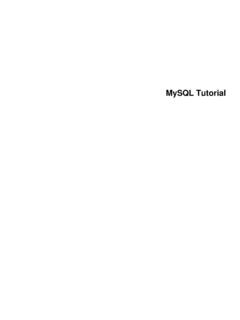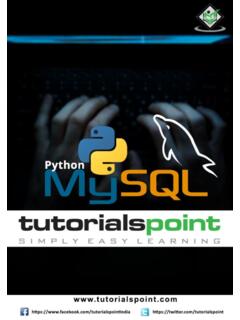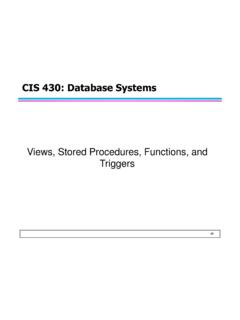Transcription of SQL Quick Guide - Tutorialspoint
1 - Quick GUIDESQL - Quick GUIDEWhat is SQL?SQL is structured query language , which is a computer language for storing, manipulating andretrieving data stored in relational is the standard language for Relation Database System. All relational database managementsystems like MySQL, MS Access, oracle , Sybase, Informix, postgres and SQL Server use SQL asstandard database , they are using different dialects, such as:MS SQL Server using T-SQL, oracle using PL/SQL,MS Access version of SQL is called JET SQL nativeformat, etcWhy SQL?Allows users to access data in relational database management users to describe the users to define the data in database and manipulate that to embed within other languages using SQL modules, libraries & users to create and drop databases and users to create view, stored procedure, functions in a users to set permissions on tables, procedures, and viewsWhat is RDBMS?
2 RDBMS stands for Relational Database Management System. RDBMS is the basis for SQL and forall modern database systems like MS SQL Server, IBM DB2, oracle , MySQL, and Microsoft Relational database management system RDBMS is a database management system DBMS thatis based on the relational model as introduced by E. F. is table ?The data in RDBMS is stored in database objects called tables. The table is a collection of relateddata entries and it consists of columns and , a table is the most common and simplest form of data storage in a is field?Every table is broken up into smaller entities called fields. The fields in the CUSTOMERS tableconsist of ID, NAME, AGE, ADDRESS and field is a column in a table that is designed to maintain specific information about every recordin the is record or row?
3 A record, also called a row of data, is each individual entry that exists in a table. For example,there are 7 records in the above CUSTOMERS record is a horizontal entity in a is column?A column is a vertical entity in a table that contains all information associated with a specific fieldin a is NULL value?A NULL value in a table is a value in a field that appears to be blank which means A field with aNULL value is a field with no is very important to understand that a NULL value is different than a zero value or a field thatcontains spaces. A field with a NULL value is one that has been left blank during record Constraints:Constraints are the rules enforced on data columns on table. These are used to limit the type ofdata that can go into a table.
4 This ensures the accuracy and reliability of the data in the could be column level or table level. Column level constraints are applied only to onecolumn where as table level constraints are applied to the whole Syntax:SQL is followed by unique set of rules and guidelines called Syntax. This tutorial gives you a quickstart with SQL by listing all the basic SQL Syntax:All the SQL statements start with any of the keywords like SELECT, INSERT, UPDATE, DELETE,ALTER, DROP, CREATE, USE, SHOW and all the statements end with a semicolon ;.Important point to be noted is that SQL is case insensitive which means SELECT and select havesame meaning in SQL statements but MySQL make difference in table names. So if you areworking with MySQL then you need to give table names as they exist in the SELECT Statement:SELECT column1, table_name;SQL DISTINCT Clause:SELECT DISTINCT column1, table_name;SQL WHERE Clause:SELECT column1, table_nameWHERE CONDITION;SQL AND/OR Clause:SELECT column1, table_nameWHERE CONDITION-1 {AND|OR} CONDITION-2;SQL IN Clause:SELECT column1, table_nameWHERE column_name IN (val-1, val-2.)
5 Val-N);SQL BETWEEN Clause:SELECT column1, table_nameWHERE column_name BETWEEN val-1 AND val-2;SQL Like Clause:SELECT column1, table_nameWHERE column_name LIKE { PATTERN };SQL ORDER BY Clause:SELECT column1, table_nameWHERE CONDITIONORDER BY column_name {ASC|DESC};SQL GROUP BY Clause:SELECT SUM(column_name)FROM table_nameWHERE CONDITIONGROUP BY column_name;SQL COUNT Clause:SELECT COUNT(column_name)FROM table_nameWHERE CONDITION;SQL HAVING Clause:SELECT SUM(column_name)FROM table_nameWHERE CONDITIONGROUP BY column_nameHAVING (arithematic function condition);SQL CREATE TABLE Statement:CREATE TABLE table_name(column1 datatype,column2 datatype,column3 datatype,..columnN datatype,PRIMARY KEY( one or more columns ));SQL DROP TABLE Statement:DROP TABLE table_name;SQL CREATE INDEX Statement :CREATE UNIQUE INDEX index_nameON table_name ( column1, column2.
6 ColumnN);SQL DROP INDEX Statement :ALTER TABLE table_nameDROP INDEX index_name;SQL DESC Statement :DESC table_name;SQL TRUNCATE TABLE Statement:TRUNCATE TABLE table_name;SQL ALTER TABLE Statement:ALTER TABLE table_name {ADD|DROP|MODIFY} column_name {data_ype};SQL ALTER TABLE Statement Rename :ALTER TABLE table_name RENAME TO new_table_name;SQL INSERT INTO Statement:INSERT INTO table_name( column1, )VALUES ( value1, );SQL UPDATE Statement:UPDATE table_nameSET column1 = value1, column2 = [ WHERE CONDITION ];SQL DELETE Statement:DELETE FROM table_nameWHERE {CONDITION};SQL CREATE DATABASE Statement:CREATE DATABASE database_name;SQL DROP DATABASE Statement:DROP DATABASE database_name;SQL USE Statement:USE DATABASE database_name;SQL COMMIT Statement:COMMIT;SQL ROLLBACK Statement:ROLLBACK.
7 SQL - Operators:SQL Arithmetic Operators:Assume variable a holds 10 and variable b holds 20, then:Show ExamplesOperatorDescriptionExample+Addit ion - Adds values on either side ofthe operatora + b will give 30-Subtraction - Subtracts right handoperand from left hand operanda - b will give -10*Multiplication - Multiplies values on eitherside of the operatora * b will give 200/Division - Divides left hand operand byright hand operandb / a will give 2%Modulus - Divides left hand operand byright hand operand and returnsremainderb % a will give 0 SQL Comparison Operators:Assume variable a holds 10 and variable b holds 20, then:Show ExamplesOperatorDescriptionExample=Check s if the values of two operands areequal or not, if yes then conditionbecomes is not true.
8 !=Checks if the values of two operands areequal or not, if values are not equal thencondition becomes !=b is true.<>Checks if the values of two operands areequal or not, if values are not equal thencondition becomes <>b is true.>Checks if the value of left operand isgreater than the value of right operand, ifyes then condition becomes >b is not true.<Checks if the value of left operand is lessthan the value of right operand, if yesthen condition becomes <b is true.>=Checks if the value of left operand isgreater than or equal to the value of rightoperand, if yes then condition >=b is not true.<=Checks if the value of left operand is lessthan or equal to the value of rightoperand, if yes then condition <=b is true.!<Checks if the value of left operand is nota!
9 <b is than the value of right operand, if yesthen condition becomes true.!>Checks if the value of left operand is notgreater than the value of right operand, ifyes then condition becomes !>b is Logical Operators:Here is a list of all the logical operators available in ExamplesOperatorDescriptionALLThe ALL operator is used to compare a value to all values in another AND operator allows the existence of multiple conditions in an SQLstatement's WHERE ANY operator is used to compare a value to any applicable value in thelist according to the BETWEEN operator is used to search for values that are within a set ofvalues, given the minimum value and the maximum EXISTS operator is used to search for the presence of a row in aspecified table that meets certain IN operator is used to compare a value to a list of literal values thathave been LIKE operator is used to compare a value to similar values usingwildcard NOT operator reverses the meaning of the logical operator with which itis used.
10 Eg: NOT EXISTS, NOT BETWEEN, NOT IN, etc. This is a OR operator is used to combine multiple conditions in an SQLstatement's WHERE NULLThe NULL operator is used to compare a value with a NULL UNIQUE operator searches every row of a specified table for - Useful Functions:SQL has many built-in functions for performing processing on string or numeric data. Following isthe list of all useful SQL built-in functions:SQL COUNT Function - The SQL COUNT aggregate function is used to count the number ofrows in a database MAX Function - The SQL MAX aggregate function allows us to select the highest maximumvalue for a certain MIN Function - The SQL MIN aggregate function allows us to select the lowest minimumvalue for a certain AVG Function - The SQL AVG aggregate function selects the average value for certaintable SUM Function - The SQL SUM aggregate function allows selecting the total for a SQRT Functions - This is used to generate a square root of a given RAND Function - This is used to generate a random number using SQL CONCAT Function - This is used to concatenate any string inside any SQL Numeric Functions - Complete list of SQL
















